Places to Visit - The Silver Coast
Alphabetical listing of just a few of the places to visit within easy reach of Foz do Arelho and Caldas da Rainha, starting
much nearer to home at the next town of Alcobaca.
A provincial town situated in a valley where the rivers Alcoa and Baca join.
Alcobaca is famous for it's Cistercian abbey, one of the finest architectural
monuments in Portugal, and one of the first examples of Gothic architecture in
Europe. The town grew up around the abbey which was an important centre in
mediaeval times. The surrounding countryside was cultivated by the monks for
almost 700 years and it remains today one of the most fertile regions in the
country.
Cistercian Monastery of Alcobaca. Begun in 1178, facade re modelled in the
17th and 18th centuries in baroque style. Gothic portal; tombs of King Pedro
and D. Ines; mediaeval sculpture; water course diverted to run through the
ancient kitchen. |
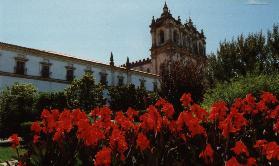 |
The town grew up around the Dominican monastery of Santa Maria de Vitoria,
or Batalha. The monastery was built to fulfil a promise made by King Joao 1st
who had prayed for victory over the Castillians at the battle of Aljubarrota in
1385.
The monastery is a majestic building classified as world heritage site by UNESCO. |
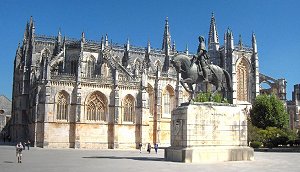 |
An old fishing village which developed into a town rapidly from the 19th century
when the royal family chose it as their summer residence. Today it is the
residential area for the Lisbon jet-set and a favourite night spot for young
people.
Coimbra stands on the banks of the River Mondego. It is the traditional cultural
centre of the country with one of the oldest and most prestigious universities in
Europe. Here the fado, bohemian life, learning and tradition are maintained
alongside the present day city which has retained it's fine monuments and
architectural heritage.
Conimbriga Ruins:-
The ancient Celtic settlement from which Coimbra took it's name, became a
regional centre under the Romans. The remains at Conimbriga are probably the
finest example of a complete Roman settlement in Europe.
Ericeira:-
This fishing port has retained many of the turn-of-the-century characteristics
which it had when the last king of Portugal sailed into exile from there in 1910 at
the time of the founding of the republic. In or out of season it is a pleasure to
sample the gastronomic delights of the restaurants overlooking the sea. Fresh
fish, vegetables and fruit, as well as the savoury sausage baked in bread and a
range of regional sweets.
Estoril:-
Situated on the coast and protected by the Serra de Sintra it has a very mild
climate. A number of former monarchs and pretenders in exile lived here: Carol
of Rumania, Umberto of Saboia, Juan de Bourbon (the father of Juan Carlos of
Spain), Edward the VII the King who abdicated the throne of England to marry
an American Mrs. Simpson, made his home near here in the Second World
War. It is a popular residential area for the growing foreign community in
Portugal. The Estoril Grand Prix is held just outside the town which has a lively
night life and casino.
Evora:-
Part of the town is enclosed by the walls and is preserved in it's original state.
Evora is included in UNESCO's World Heritage list. It was known by the
Romans as Liberalitas Julia and vestiges of walls and rooms, and the
monumental imperial temple, still remain from this period.
Evora was wrested from the Moors by Geraldo the fearless in 1166 and was
one of the most dynamic cities in the Kingdom of Portugal during the Middle
Ages. The court was resident here for long spells and Evora became the scene
for many royal weddings.
Particularly thriving during the Avis dynasty (1385-1580), it was formerly a
major centre for the humanities. The university was founded by Jesuits in 1551,
and it was here that the great European Masters such as Clenardo passed on
their teachings.
The roman temple, the cathedral, the variety of architectural styles (Gothic,
Manueline, mannerist and baroque), the palaces squares and narrow streets all
form part of this museum city.
Fatima:-
Fatima is now one of the most important Marian shrines in the world. It was the
birthplace of three young goat herders, Lucia, Francisco and Jacinta who
became famous when they saw apparitions of Our Lady of Fatima from the
13th May to the 13th of October 1917. The town is approached through the
Serra de Aire, a national park of holm oaks, olive trees and pines. There are
pilgrimages every 13th of the month, especially in May and October. There is a
wax museum which illustrates the apparitions of 1917.
Loures:-
Loures is just to the north of Lisbon in a country area where small farmers of
Arab origin grew fresh green vegetables. For many centuries it was a summer
residence for wealthy Lisbon families. The town was the first to proclaim the
founding of the Republic. It is proud of the lovely Palacio do Correio-Mor, one
of the finest pieces of Architecture on the outskirts of Lisbon.
Mafra:-
Mafra consists of two areas. The old town which grew up around a castle, the
remains of which is almost lost amongst the houses. The 18th century part is
relatively more recent. Developed in the shadow of the majestic monastery
constructed by King Joao V.
It was built with gold from Brazil and in fulfillment of a promise made for the
birth of an heir to the throne. Thousand of men from all over the country were
used to carry the necessary stone.
This impressive building, monastery, basilica, and palace has fine views from
the dome and small towers overlooking the game preserve and park. The town
is well known for it's Sunday carillon concerts and traditional cakes.
A mediaeval gem only five kilometers from Caldas da Rainha. This town is
carefully preserved inside the walls of it's castle. It still retains it's cobbled
narrow streets of brilliant white houses with flowers hanging from the window
boxes. The painter Josefa de Obidos lived and worked here. The whole town,
which has been classified as a National Monument, was traditionally the gift of
the Kings of Portugal to their Queens. |
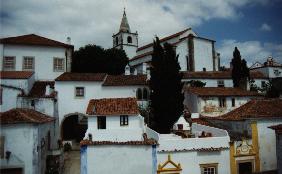 |
One of the most important fishing ports in the country on the Cabo Carvoeiro.
Peniche stands on a small peninsula forming two bays. The fort there served as
a political prison during the Fascist Salazar regime and the municipal museum
there records this era.
Nearby is the uninhabited archipelago of the Berlengas islands. An important
nature reserve which can be reached by boat when the sea is calm. |
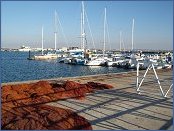 |
Queluz:-
In the 17th century it was a small hamlet with one or two country houses of
note. One of these, which led to it's development, was built by the future King
Pedro III. A royal residence from 1794. The various wings of the building are
surrounded by gardens in the rococo style. A pleasing combination which
makes this one of the most charming of Portuguese palaces. It is now open as a
museum and theatrical performances are held there as well as riding displays of
Alta Escola Portuguesa. The palace is also used as an official residence for
State Visits.
Santarem:-
Situated on a slope on the north bank of the River Tagus, Santarem is the centre
of the rich agricultural plains of the Ribatejo where mounted herdsmen still drive
the black fighting bulls to pasture. S. Francisco convent 13th century Gothic,
Gothic stone chair, Manueline cloister and arches. The Graca church is
exuberantly Gothic in style and contains the tomb of Pedro Alvares Cabral,
discoverer of Brazil. |
 |
Poetically described by Lord Byron as "this glorious Eden", Sintra is
surrounded by greenery and is rich in different species of vegetation. A
romantic town with a turn-of-the-century atmosphere, it's luxuriant vegetation
hides numerous country houses and chalets which blend perfectly into the
landscape.
It was the summer residence of Portuguese kings from the end of the 16th
century. It was here that D. Ferdinand de Saxe Coburg built a revivalist palace
(The Pena Palace) in the style of one of the castles of his cousin Ludwig II of
Bavaria.
Nowadays it is a favourite spot for visitors who like to discover it on foot or in
one of the horse-drawn carriages for hire in the main square of the town. The
15th century palace in the village is well worth seeing for the painted ceilings and
the Moorish patio.
The simplicity of the Capuchos convent in the Sintra hills is well worth the drive
out. |
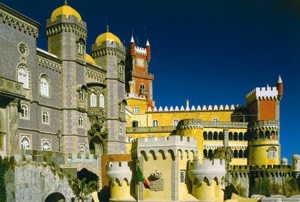 |
Tomar:-
Tomar is virtually a living museum with a fascinating collection of historic
monuments representing different periods of architecture from Roman to
Baroque. One of the most outstanding examples is the Convent of Christ, an
octagonal church which has been classified by UNESCO as being of "world
interest". Today it is one of the symbols of the decorative style which emerged
during the reign of King Manuel 1st and is known as "Manueline".
The convent was the headquarters of the Knights Templar and was closely
linked to the Portuguese maritime discoveries through Infante D. Henrique who
was Master of the Order.
Also there is the only surviving mediaeval Hebrew temple at the
Synagogue/Abrao Zacuto and the Luso Hebraic Museum.
The town, on the left bank of the River Sisandro, is well known for the Lines of
Torres Vedras which, in 1810, played a decisive role in the defence of Lisbon
against Napoleonic troops under the command of Marchal Massena. Nearby is
the gothic convent of Varatojo with 18th century additions. In the town is the
Castle and Sta. Maria do Castelo Church, 12th to 16th century. The S.
Quintinho church 2 km. from Sobral do Monte Agraco has a Manueline portal
and 16th century paintings by Gregorio Lopes.

Read the Portugal Silver Coast Property Blog

Villas for Golf Holidays nr. Praia d'el Rey Golf, Portugal
©HARLEYSTREET.NET 1998 - 2009 All Rights Reserved |








